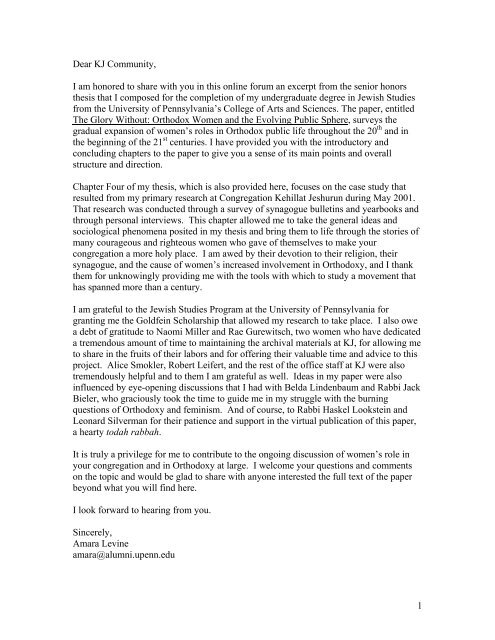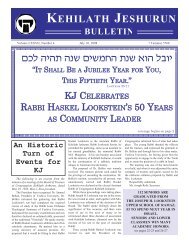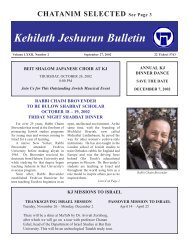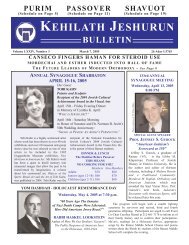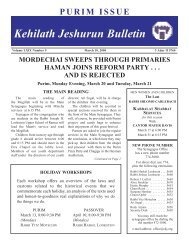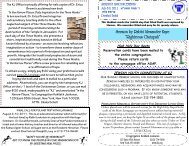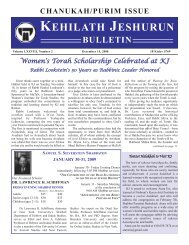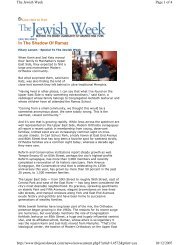The Women of KJ - Congregation Kehilath Jeshurun
The Women of KJ - Congregation Kehilath Jeshurun
The Women of KJ - Congregation Kehilath Jeshurun
Create successful ePaper yourself
Turn your PDF publications into a flip-book with our unique Google optimized e-Paper software.
Dear <strong>KJ</strong> Community,<br />
I am honored to share with you in this online forum an excerpt from the senior honors<br />
thesis that I composed for the completion <strong>of</strong> my undergraduate degree in Jewish Studies<br />
from the University <strong>of</strong> Pennsylvania’s College <strong>of</strong> Arts and Sciences. <strong>The</strong> paper, entitled<br />
<strong>The</strong> Glory Without: Orthodox <strong>Women</strong> and the Evolving Public Sphere, surveys the<br />
gradual expansion <strong>of</strong> women’s roles in Orthodox public life throughout the 20 th and in<br />
the beginning <strong>of</strong> the 21 st centuries. I have provided you with the introductory and<br />
concluding chapters to the paper to give you a sense <strong>of</strong> its main points and overall<br />
structure and direction.<br />
Chapter Four <strong>of</strong> my thesis, which is also provided here, focuses on the case study that<br />
resulted from my primary research at <strong>Congregation</strong> Kehillat <strong>Jeshurun</strong> during May 2001.<br />
That research was conducted through a survey <strong>of</strong> synagogue bulletins and yearbooks and<br />
through personal interviews. This chapter allowed me to take the general ideas and<br />
sociological phenomena posited in my thesis and bring them to life through the stories <strong>of</strong><br />
many courageous and righteous women who gave <strong>of</strong> themselves to make your<br />
congregation a more holy place. I am awed by their devotion to their religion, their<br />
synagogue, and the cause <strong>of</strong> women’s increased involvement in Orthodoxy, and I thank<br />
them for unknowingly providing me with the tools with which to study a movement that<br />
has spanned more than a century.<br />
I am grateful to the Jewish Studies Program at the University <strong>of</strong> Pennsylvania for<br />
granting me the Goldfein Scholarship that allowed my research to take place. I also owe<br />
a debt <strong>of</strong> gratitude to Naomi Miller and Rae Gurewitsch, two women who have dedicated<br />
a tremendous amount <strong>of</strong> time to maintaining the archival materials at <strong>KJ</strong>, for allowing me<br />
to share in the fruits <strong>of</strong> their labors and for <strong>of</strong>fering their valuable time and advice to this<br />
project. Alice Smokler, Robert Leifert, and the rest <strong>of</strong> the <strong>of</strong>fice staff at <strong>KJ</strong> were also<br />
tremendously helpful and to them I am grateful as well. Ideas in my paper were also<br />
influenced by eye-opening discussions that I had with Belda Lindenbaum and Rabbi Jack<br />
Bieler, who graciously took the time to guide me in my struggle with the burning<br />
questions <strong>of</strong> Orthodoxy and feminism. And <strong>of</strong> course, to Rabbi Haskel Lookstein and<br />
Leonard Silverman for their patience and support in the virtual publication <strong>of</strong> this paper,<br />
a hearty todah rabbah.<br />
It is truly a privilege for me to contribute to the ongoing discussion <strong>of</strong> women’s role in<br />
your congregation and in Orthodoxy at large. I welcome your questions and comments<br />
on the topic and would be glad to share with anyone interested the full text <strong>of</strong> the paper<br />
beyond what you will find here.<br />
I look forward to hearing from you.<br />
Sincerely,<br />
Amara Levine<br />
amara@alumni.upenn.edu<br />
1
<strong>The</strong> Glory Without: Orthodox <strong>Women</strong> and the Evolving Public Sphere<br />
Amara Levine<br />
University <strong>of</strong> Pennsylvania<br />
Jewish Studies Senior Honors <strong>The</strong>sis<br />
December 20, 2001<br />
-----------------------------------------------------<br />
Introduction<br />
“All the glory <strong>of</strong> the king’s daughter is within.” – Psalms 45:14<br />
“A woman <strong>of</strong> valor, who can find her? Her price is far above rubies.” – Proverbs 31:10<br />
<strong>The</strong> 31 st chapter <strong>of</strong> the book <strong>of</strong> Proverbs contains an alphabetical acrostic that<br />
sings the praises <strong>of</strong> the ideal woman. <strong>The</strong> appropriate role <strong>of</strong> the eishet chayil, or woman<br />
<strong>of</strong> valor, is one that has troubled both secular and religious scholars for time immemorial.<br />
<strong>The</strong> image <strong>of</strong> that woman has certainly not been based only on the 22 verses that<br />
comprise the Biblical poem. Jewish tradition, from the Bible to modern works on<br />
practical halakhah (Jewish law), is replete with references to and discussion <strong>of</strong> women<br />
and their place in the Jewish community. <strong>The</strong> topic <strong>of</strong> this paper will be how 20 th century<br />
American Orthodoxy interpreted that rich tradition and dictated for women a role that<br />
was continuously evolving and venturing further into the public sphere. A key question<br />
to keep in mind throughout the analysis is who exactly it is that defines Orthodoxy and<br />
has the power to dictate women’s roles.<br />
Chapter 1, entitled “Private/Public Spheres and <strong>The</strong>ir Applicability to<br />
Orthodoxy,” addresses the notion <strong>of</strong> a world divided into two spheres <strong>of</strong> activity, namely,<br />
private and public, and the gender affiliations associated with them, female and male,<br />
2
espectively. Abstract concepts like spheres <strong>of</strong> activity are difficult to define and are in<br />
actuality more malleable than any concise definition can account for. With that in mind,<br />
Chapter 1 attempts to define private and public spheres in terms <strong>of</strong> two other social<br />
dichotomies, nature/culture and family/work, and raises the question <strong>of</strong> whether these<br />
gendered dichotomies are biologically or socially determined. Working with the<br />
assumption that it is the confluence <strong>of</strong> many different factors that shapes the<br />
private/public model, the chapter applies the complex model to traditional Judaism’s<br />
treatment <strong>of</strong> women with respect to the private and public spheres. Finally, the rabbis’<br />
transformation <strong>of</strong> the mechitzah, or wall indicating the division between the men’s and<br />
women’s sections in an Orthodox prayer service, into an edifice that provides women<br />
with historically unprecedented access to the public aspects <strong>of</strong> Orthodoxy is incorporated<br />
into the chapter to symbolize the changing and expanding role <strong>of</strong> the Orthodox eishet<br />
chayil.<br />
Chapter 2, “Synagogue Sisterhoods and the Mediation <strong>of</strong> Spheres,” <strong>of</strong>fers a<br />
historical contextualization <strong>of</strong> the American women’s volunteer group movement and,<br />
more specifically, Orthodox synagogue sisterhoods. Much like the secular volunteer<br />
women <strong>of</strong> the early 20 th century were expected to spend their time “mothering” society<br />
and saving it from vice, the Orthodox volunteer women <strong>of</strong> the synagogue sisterhood<br />
movement were responsible for “raising” the Orthodox community and saving it from the<br />
threat <strong>of</strong> assimilation. This was accomplished by transforming the Jewish home into a<br />
miniature sanctuary and, more importantly, reshaping the synagogue, the center <strong>of</strong> Jewish<br />
public worship, into a more home-like environment. Sisterhood women took upon<br />
themselves the duties <strong>of</strong> communal motherhood, such as food preparation, hospitality,<br />
3
decorating, and education. By applying their domestic proclivity to the synagogue,<br />
sisterhood women served as a mediating force between the seemingly dichotomous<br />
private and public spheres. Although, under ordinary circumstances, Orthodox rabbis<br />
might have frowned upon women focusing their energies on participation in the public<br />
sphere, the fact that their activities were couched in terms <strong>of</strong> mothering and expanding<br />
that role to the community at large allowed their behavior to remain acceptable and<br />
rooted in traditional gender roles.<br />
Chapter 3 addresses the next major stage <strong>of</strong> women’s increased involvement in<br />
the public sphere: “Orthodox Feminism: A Foray Into the Public Sphere.” <strong>The</strong> Oxford<br />
English Dictionary defines “feminism” as advocacy <strong>of</strong> the rights <strong>of</strong> women based on the<br />
theory <strong>of</strong> equality <strong>of</strong> the sexes. While classical Judaism never explicitly deems women<br />
inferior to men, there are many structures within the halakhic system that prevent women<br />
from ever achieving true equality with men. For instance, as the Orthodox interpretation<br />
<strong>of</strong> mainstream halakhah currently stands, women cannot lead public prayers or serve as<br />
rabbis. Thus, the term Orthodox feminism seems to be somewhat <strong>of</strong> an oxymoron. It can<br />
best be understood as a movement striving to maximize opportunities for women within<br />
Orthodoxy and its legal restrictions. Two examples <strong>of</strong> halakhic innovations meant to<br />
maximize women’s public participation in Orthodoxy are women’s tefillah groups and<br />
synagogue interns, both <strong>of</strong> which are dealt with at length in Chapter 3. Although<br />
introducing new opportunities like these serves to grant women greater access to the<br />
public aspects <strong>of</strong> their religion, Orthodox women remain excluded from the most public<br />
role <strong>of</strong> all: the rabbinate. This chapter takes up some <strong>of</strong> the sociological issues related to<br />
Orthodoxy’s treatment <strong>of</strong> women’s battle for rabbinic ordination and draws parallels<br />
4
etween Reform, Conservatism, and Orthodoxy. <strong>The</strong> discussion <strong>of</strong> Orthodox feminism<br />
ends with the acknowledgement that, for the majority <strong>of</strong> Orthodox congregations in<br />
America, women’s foray into the public sphere is not about tefillah groups or institutional<br />
leadership positions. Rather, it is grass-roots changes like increased educational<br />
opportunities that are bringing women out <strong>of</strong> their homes and sisterhood meetings and<br />
into a higher level <strong>of</strong> engagement with their synagogues.<br />
An example <strong>of</strong> a congregation in which Orthodox women have experienced the<br />
evolution <strong>of</strong> the public sphere is Manhattan’s <strong>Congregation</strong> <strong>Kehilath</strong> <strong>Jeshurun</strong> (<strong>KJ</strong>), the<br />
subject <strong>of</strong> Chapter 4. <strong>The</strong> congregation has a rich history <strong>of</strong> women’s involvement, and<br />
Chapter 4 traces the development <strong>of</strong> their congregational activity from the beginnings <strong>of</strong><br />
the sisterhood organization to a long period <strong>of</strong> consciousness-raising about women and<br />
halakhah to the culmination <strong>of</strong> that discussion in the recent appointment <strong>of</strong> women to the<br />
position <strong>of</strong> synagogue <strong>of</strong>ficer. <strong>The</strong> history <strong>of</strong> <strong>KJ</strong> indeed reflects many <strong>of</strong> the broad<br />
historical and sociological phenomena touched upon in the first three chapters <strong>of</strong> this<br />
paper.<br />
It is, however, important to realize two things about the use <strong>of</strong> such a case study.<br />
First, it is by definition just a case study, an example <strong>of</strong> just one American congregation’s<br />
treatment <strong>of</strong> women and not necessarily an indication <strong>of</strong> how the issue <strong>of</strong> women in the<br />
synagogue was addressed in other communities. However, focusing on a specific<br />
community allows the abstract concepts <strong>of</strong> private and public spheres and gendered<br />
activity to be brought to life and understood in a practical framework. <strong>The</strong> second<br />
consideration with respect to Chapter 4 is its use <strong>of</strong> synagogue bulletins and yearbooks as<br />
foundations for tracing the chronology <strong>of</strong> events. From a historical perspective, such<br />
5
documents tend to be overly celebratory and highlight major synagogue events and<br />
accomplishments without acknowledging the behind-the-scenes labor and strife that goes<br />
into synagogue work. Some voices <strong>of</strong> individuals from the <strong>KJ</strong> community have been<br />
inserted to address the deficiency inherent in analyzing synagogue-generated documents.<br />
However, it is also interesting to recognize that the <strong>KJ</strong> bulletins and yearbooks reflect<br />
how the congregation wishes to be remembered. <strong>The</strong> documentation <strong>of</strong> women’s activity<br />
in the congregation, whether sisterhood-, education-, or administration-related, indicates<br />
that <strong>KJ</strong> considers itself part <strong>of</strong> the national discourse concentrating on the changing roles<br />
<strong>of</strong> Orthodox women and their relationship to the private and public spheres.<br />
6
Chapter 4: <strong>Congregation</strong> <strong>Kehilath</strong> <strong>Jeshurun</strong>: A Case Study in Orthodox <strong>Women</strong><br />
and the Evolving Public Sphere 1<br />
“[<strong>The</strong> woman <strong>of</strong> valor] looks well to the ways <strong>of</strong> her household and the bread <strong>of</strong> idleness<br />
she does not eat.” – Proverbs 31:27<br />
<strong>The</strong> question <strong>of</strong> the role <strong>of</strong> the observant woman in American Orthodoxy has been<br />
gaining momentum for more than a century. While many scholars, like Pr<strong>of</strong>essor Tamar<br />
Ross, emphasize its salience in our day and age and “now more than ever… regard the<br />
status <strong>of</strong> women…as the greatest current challenge to Orthodoxy,” 2 the issue has a great<br />
deal <strong>of</strong> historical significance as well. <strong>The</strong> treatment <strong>of</strong> women in an American<br />
congregation was <strong>of</strong>ten a gauge for how distinctly “Americanized” that congregation<br />
was. For example, one defining feature <strong>of</strong> a “new shul” in America in the first decade<br />
and a half <strong>of</strong> the 20 th century was its “inclusion <strong>of</strong> women,” an invitation that earlier<br />
immigrant congregations <strong>of</strong>ten did not extend. 3<br />
<strong>Congregation</strong> <strong>Kehilath</strong> <strong>Jeshurun</strong> 4 , known<br />
at that time as Khal Anshe <strong>Jeshurun</strong>, 5 incorporated women into its congregation structure<br />
even before the onset <strong>of</strong> the 20 th century. An historical record <strong>of</strong> <strong>KJ</strong>, compiled for the<br />
congregation’s 1946 yearbook, documents organized activities by a Ladies Auxiliary<br />
Society as early as 1886. <strong>The</strong>se activities included the presentation <strong>of</strong> a Torah to the<br />
congregation and the coordination <strong>of</strong> a fund raising “strawberry festival” that, like other<br />
1 While many <strong>of</strong> the examples cited in this chapter are taken from the 1950s and beyond, the sisterhood<br />
activities described here are indicative <strong>of</strong> those taking place since the organization’s inception in 1930.<br />
2 Ross, Tamar. “Modern Orthodoxy and the Challenge <strong>of</strong> Feminism.” Jews and Gender: <strong>The</strong> Challenge to<br />
Hierarchy (Studies in Contemporary Jewry XVI). Ed. Jonathan Frankel. Oxford: Oxford U.P, 2000, 3.<br />
3 Kaufman, David. Shul With a Pool: <strong>The</strong> “Synagogue-Center” in American Jewish History. Hanover, NH:<br />
U.P <strong>of</strong> New England, 1999, 191.<br />
4 Referred to hereafter as <strong>KJ</strong>.<br />
5 <strong>The</strong> name Kehillat <strong>Jeshurun</strong>, “a far more American and socially inclusive appellation than the traditionalsounding<br />
and -meaning ‘Anshe <strong>Jeshurun</strong>’,” (Joselit, Jenna W. New York’s Jewish Jews. Bloomington:<br />
Indiana U.P, 1990, 29) was chosen around 1881, according to Lookstein, Joseph. “Seventy-Five<br />
Yesteryears: A Historical Sketch <strong>of</strong> <strong>Kehilath</strong> <strong>Jeshurun</strong>.” <strong>KJ</strong> Yearbook, 1946, 22.<br />
7
such festivals at that time, probably featured delectable strawberry treats, arts and crafts,<br />
and fun family activities. 6<br />
While <strong>KJ</strong> is somewhat <strong>of</strong> an exception in its early<br />
incorporation <strong>of</strong> women into its communal body, its focus on the importance <strong>of</strong><br />
maintaining a congregational history made it a good case study for tracing the gradually<br />
increased role <strong>of</strong> women in the American Orthodox synagogue during the last 125 years.<br />
Seeking to integrate traditional Orthodoxy into the upscale way <strong>of</strong> life on Manhattan’s<br />
Upper East Side, <strong>KJ</strong> consistently <strong>of</strong>fered its female congregants a level <strong>of</strong> access to<br />
public religious life that paralleled women’s roles in other facets <strong>of</strong> American life.<br />
<strong>KJ</strong> had no reservations about identifying itself as a distinctly American<br />
synagogue. <strong>The</strong> historical record <strong>of</strong> the congregation mentioned above opens with the<br />
recognition that “an institution is not born in a vacuum; nor is it created ex nihilo. It is<br />
the product <strong>of</strong> the time, a result <strong>of</strong> the dynamic forces <strong>of</strong> life…” <strong>The</strong> historical account<br />
proceeds to paint the picture <strong>of</strong> “the world in which <strong>Kehilath</strong> <strong>Jeshurun</strong> was born,”<br />
namely, a New York City that was slowly growing into its own unique culture <strong>of</strong> fashion,<br />
mass transportation, and recreation. <strong>KJ</strong>’s history further notes that the congregation was<br />
founded with the intent to “bridge the gulf” between the “up-town richer and<br />
Americanized Jews and the poorer [more devout] Jews on the lower east side.” <strong>The</strong><br />
congregation’s founders were highly cognizant <strong>of</strong> the American Jewish population in<br />
which they found themselves, one in which “assimilation was on the march” and on<br />
which intermarriage had taken its toll by driving many Jews to “sever their ties with the<br />
synagogue and…maintain only a social contact with their people.” 7<br />
From its very<br />
inception, <strong>KJ</strong> acknowledged its role as a congregation designed to help those upscale<br />
6 Lookstein 22.<br />
7 Lookstein 17-20.<br />
8
Manhattan Jews who were looking to maintain a strong American identity find a place for<br />
themselves within Orthodoxy as well.<br />
In line with this philosophy <strong>of</strong> integrating the religious and the secular was <strong>KJ</strong>’s<br />
commitment to treating women much like they were treated in the contemporary society.<br />
That parallel was expressed overtly in the history <strong>of</strong> the <strong>KJ</strong> sisterhood also commissioned<br />
for the 1946 yearbook:<br />
It was in the late Victorian period that the women <strong>of</strong> <strong>Kehilath</strong> <strong>Jeshurun</strong><br />
became active in the affairs <strong>of</strong> the congregation and in the affairs <strong>of</strong> the<br />
community at large. During that era, a woman would be considered<br />
indiscreet if she were interested in books…She was expected to be shy,<br />
charming, dependent, and even slightly capricious. It was during that<br />
period that the Sisterhood came into being.<br />
According to that same historical account, the <strong>KJ</strong> sisterhood records from the 19 th century<br />
contain an 1886 article from <strong>The</strong> Jewish Messenger telling <strong>of</strong> the “interesting ceremony”<br />
that accompanied the Sefer Torah dedication and a “record…in the press” <strong>of</strong> a June 10,<br />
1887 “Strawberry Festival” that was “largely attended and netted quite a large amount.” 8<br />
<strong>The</strong> coordination <strong>of</strong> such family-oriented events was considered activity <strong>of</strong> the home<br />
extended and was thus suitable feminine behavior for upscale American Jewish women<br />
<strong>The</strong> onset <strong>of</strong> the 20 th century brought a slight shift in focus for the women <strong>of</strong> the<br />
<strong>KJ</strong> Ladies’ Auxiliary, as they began to take on the “religious education <strong>of</strong> the young as<br />
their special concern.” An October 1908 meeting was called, probably by the sisterhood<br />
president, for the women <strong>of</strong> <strong>KJ</strong> to spark their interest in the “care and discipline <strong>of</strong>” the<br />
congregation’s religious school. 9<br />
<strong>The</strong> women tended to the needs <strong>of</strong> <strong>KJ</strong>’s youth<br />
8 Etra, Mrs. Harry. “Jewish Womanhood in Action: A History <strong>of</strong> the <strong>Kehilath</strong> <strong>Jeshurun</strong> Sisterhood.” <strong>KJ</strong><br />
Yearbook, 1946, 39.<br />
9 Note the use <strong>of</strong> the mothering terms “care” and “discipline” with respect to women’s role in educating the<br />
congregation. For more details on education as a motherly responsibility, see Hyman, Paula. Gender and<br />
Assimilation in Modern Jewish History. Seattle: Univ. <strong>of</strong> Washington Press, 1995, 19 and 25-27. For more<br />
9
education arm until the school broke away from the congregation and formed the<br />
autonomous Central Jewish Institute (CJI) in 1916. Remaining loyal to the cause <strong>of</strong><br />
Jewish education, the Ladies’ Auxiliary that was formerly affiliated with <strong>KJ</strong> instead came<br />
to view itself as the <strong>of</strong>ficial women’s organization <strong>of</strong> the CJI, leaving <strong>KJ</strong> without a<br />
woman’s branch for almost 15 years. 10<br />
In light <strong>of</strong> the many women’s volunteer groups and benevolent societies popping<br />
up all over America, the absence <strong>of</strong> a women’s organization affiliated with <strong>KJ</strong> left<br />
associate Rabbi Joseph Lookstein feeling uneasy. He worked to bring the women <strong>of</strong> the<br />
congregation together to form a sisterhood and he succeeded in March <strong>of</strong> 1930, when the<br />
women <strong>of</strong> the regular <strong>KJ</strong> bible class were finally compelled by Rabbi Lookstein’s<br />
romanticized argument that “a congregation without a sisterhood is like a home without a<br />
mother.” Lookstein defined the sisterhood as that force which “brings in a spirit <strong>of</strong><br />
hospitality, friendship, sociability and warmth into a congregation.” <strong>The</strong> dedicated<br />
volunteer women <strong>of</strong> the <strong>KJ</strong> sisterhood took Rabbi Lookstein’s charge very seriously and<br />
“sought to demonstrate by work and deeds the traditional role <strong>of</strong> service and devotion <strong>of</strong><br />
the Jewish woman.” 11<br />
Mrs. Harry Etra, 12 author <strong>of</strong> the sisterhood historical account for the 1946 <strong>KJ</strong><br />
Yearbook, asks, “[W]hat role did the Sisterhood play in the life and fortunes <strong>of</strong> <strong>Kehilath</strong><br />
<strong>Jeshurun</strong>?” Herself an active member <strong>of</strong> the <strong>KJ</strong> sisterhood, Etra recognizes the inability<br />
on sisterhoods accepting the responsibility <strong>of</strong> communal education as part <strong>of</strong> their involvement in public<br />
forms <strong>of</strong> motherhood, see Nadell, Pamela and Simon, Rita. “Ladies <strong>of</strong> the Sisterhood: <strong>Women</strong> in the<br />
American Reform Synagogue, 1900-1930.” Active Voices. Ed. Maurie Sacks. Urbana: Univ. <strong>of</strong> Illinois<br />
Press, 1995, 67.<br />
10 Etra 39.<br />
11 Etra 40.<br />
12 It is interesting to note that throughout the <strong>KJ</strong> yearbooks and bulletins, women are referred to as the<br />
“Mrs.” <strong>of</strong> their husbands, never by their own first names. This phenomenon occurred as late as the June 30,<br />
1988 <strong>KJ</strong> Bulletin.<br />
10
to answer this question fully, saying that “one might as well ask what role did and does a<br />
mother play in the life <strong>of</strong> her family. <strong>The</strong>re are functions too many to mention…” Just<br />
like mothers, sisterhood women were expected to perform many unseen, unpaid, and<br />
unrecognized deeds. Nevertheless, Etra “attempt[s] to enumerate…some <strong>of</strong> the activities<br />
and to list only several <strong>of</strong> the contributions <strong>of</strong> the [sisterhood] organization.” Part <strong>of</strong> the<br />
sisterhood’s “service to the synagogue” was, “like the woman <strong>of</strong> valor in Proverbs…<br />
[who] looketh well to the ways <strong>of</strong> her household, 13 …[making] the synagogue…more<br />
beautiful a place for the living and more holy a shrine for the departed.” This was<br />
accomplished through the sisterhood’s diligence in ensuring the presence <strong>of</strong> cushions on<br />
the pews <strong>of</strong> the sanctuary, velvet curtains over the Aron Kodesh (Holy Ark), adornments<br />
for the Torah scrolls, the “beautiful Memorial Tablets… inscribed [with] the names <strong>of</strong><br />
departed dear ones,” and drapes on the windows <strong>of</strong> the synagogue social hall. 14<br />
<strong>The</strong>re are many other examples <strong>of</strong> this behind-the-scenes type <strong>of</strong> service<br />
throughout the <strong>KJ</strong> sisterhood history. In 1950, the sisterhood presented a spinet piano to<br />
the congregation for use in the social hall. <strong>The</strong> <strong>KJ</strong> Bulletin reported the piano to be<br />
“beautiful to the eye and most pleasing to the ear” and thanked the sisterhood “for<br />
making our lovely Social Hall still lovelier.” 15<br />
It was also noted that in 1954, the<br />
sisterhood had done an exceptional job <strong>of</strong> decorating the congregational sukkah, 16 an<br />
extension <strong>of</strong> the “home” motif <strong>of</strong> the synagogue. 17<br />
Rae Gurewitsch, a former president <strong>of</strong><br />
the <strong>KJ</strong> sisterhood and the current Second Vice President <strong>of</strong> the congregation, recalls that<br />
13 Quoting Proverbs 31:27.<br />
14 Etra 40-41.<br />
15 <strong>KJ</strong> Bulletin, June 2, 1950.<br />
16 <strong>KJ</strong> Bulletin, October 29, 1954.<br />
17 In Jewish law, the sukkah is treated as a temporary dwelling, one that observers <strong>of</strong> Sukkot are to view as<br />
their home for the duration <strong>of</strong> the holiday.<br />
11
in the early 1970s, the sisterhood donated hand-made needlepoint Torah covers to the<br />
shul. 18<br />
<strong>The</strong> women <strong>of</strong> the sisterhood also presented <strong>KJ</strong> with a needlepoint chupah<br />
(wedding canopy) in 1978, a project to which thirty female congregants <strong>of</strong>fered their<br />
creative talents. 19<br />
In addition to tending to the synagogue “home,” the sisterhood women,<br />
“consistent with the tradition <strong>of</strong> motherhood…made the children <strong>of</strong> the congregation its<br />
special concern.” Like mothers packing snacks for their children to hold them over until<br />
the conclusion <strong>of</strong> synagogue services, the sisterhood women “provide[d] goodies and<br />
holiday souvenirs for the children” during special times like Chanukah, Purim, and<br />
Simchat Torah. <strong>The</strong>y also presented each <strong>KJ</strong> Bar Mitzvah boy with a prayer book “as a<br />
memento <strong>of</strong> an important day in the life <strong>of</strong> a maturing Jewish boy.” 20<br />
Also in line with<br />
their role as the mothers <strong>of</strong> the synagogue, they facilitated the transmission <strong>of</strong> Jewish<br />
values through youth education. <strong>The</strong>y were strong supporters, financially and otherwise,<br />
<strong>of</strong> the Ramaz School, founded in 1936 to provide boys and girls with a top-notch Jewish<br />
and secular education, and <strong>of</strong> summer camps that enriched the religious experience <strong>of</strong> the<br />
congregation’s young people. 21<br />
For instance, the <strong>KJ</strong> Bulletin recorded that, at the annual<br />
closing meeting <strong>of</strong> the <strong>KJ</strong> sisterhood in 1950, the sisterhood president told <strong>of</strong> the great<br />
financial success <strong>of</strong> events throughout the year, such as the Donor Luncheon, that<br />
allowed the sisterhood to send “substantial gifts” to the Educational Scholarship Funds <strong>of</strong><br />
Ramaz, the congregational Religious School, and the Camp Fund. 22<br />
18 Gurewitsch, Rae. Personal interview. 16 May 2001.<br />
19 <strong>KJ</strong> Bulletin, March 10, 1978.<br />
20 <strong>The</strong> <strong>KJ</strong> sisterhood later changed its policy and extended its gift-giving to Bat Mitzvah girls as well.<br />
21 Etra 41.<br />
22 <strong>KJ</strong> Bulletin, June 2, 1950.<br />
12
Etra also wrote <strong>of</strong> the cultural, social, and philanthropic activities <strong>of</strong> the <strong>KJ</strong><br />
sisterhood. Events contributing to the “cultural enrichment” <strong>of</strong> the sisterhood women<br />
included speakers and presenters at the organization’s meetings. 23 For instance, in 1954-<br />
1955, sisterhood meetings featured presentations by Mrs. Richard Stewart <strong>of</strong> the New<br />
York Horticultural Society on the incorporation <strong>of</strong> houseplants into home décor, Dvora<br />
Lapson <strong>of</strong> the Jewish Education Committee <strong>of</strong> New York on “<strong>The</strong> Jew and the Dance,”<br />
and Blix Ruskay, the “one woman show,” on Yiddish and Hebrew folklore. 24 In addition,<br />
“formal classes <strong>of</strong> instruction for women” in topics like “Hebrew, Bible, Jewish History,<br />
and Jewish Religious Practice” were maintained throughout the years, and it was from the<br />
precursor to one such sisterhood-<strong>of</strong>ficiated class that the organization itself was born. 25<br />
<strong>The</strong>se culturally enriching activities indicate the beginnings <strong>of</strong> a value placed on<br />
women’s cultural well-roundedness and not simply on their adeptness at domestic tasks.<br />
<strong>The</strong> social activities, a wide range <strong>of</strong> programs including theater parties, teas, and<br />
holiday celebrations prepared with a distinctly female flair, all “contributed greatly to the<br />
cementing <strong>of</strong> friendship and to the cultivation <strong>of</strong> a real family atmosphere in the<br />
congregation.” 26<br />
One such example was the January 30, 1950 Luncheon and Card Party,<br />
described as “one <strong>of</strong> those gatherings where the members <strong>of</strong> the Sisterhood and their<br />
friends will have a chance to get together in a purely social atmosphere to have a bite and<br />
enjoy themselves at cards, mah jongg, and what have you,” 27 much like an intimate social<br />
gathering that a woman would prepare in her own home. In the way <strong>of</strong> philanthropy, the<br />
sisterhood “contributed regularly and generously to a variety <strong>of</strong> causes,” including the<br />
23 Etra 42.<br />
24 <strong>KJ</strong> Bulletin, November 19, December 10, and December 31, 1954.<br />
25 Etra 42.<br />
26 Etra 42.<br />
27 <strong>KJ</strong> Bulletin, January 13, 1950.<br />
13
Federation for the Support <strong>of</strong> Jewish Philanthropic Societies, the Red Cross, the Jewish<br />
Welfare Board, Yeshiva University, United Jewish Appeal, and ORT, and “encouraged<br />
its members as individuals to contribute to organized philanthropy.” 28<br />
<strong>The</strong> sisterhood<br />
also generated a strong volunteer ethic and, to that end, planned trips like the 1954 visit to<br />
the Home for the Aged and Infirm Hebrews. 29<br />
<strong>The</strong>se types <strong>of</strong> involvements were standard sisterhood activity from the<br />
organization’s inception until, to some extent, even the present day. 30<br />
While the<br />
beginnings <strong>of</strong> women’s involvements in the communal aspects <strong>of</strong> <strong>KJ</strong> were in the<br />
sisterhood, the role and status <strong>of</strong> women in the congregation slowly grew to parallel those<br />
<strong>of</strong> their male counterparts. <strong>The</strong> first step in this direction was taken in 1949, when the <strong>KJ</strong><br />
Board <strong>of</strong> Trustees decided to grant “special membership” status, which was previously<br />
limited to the widows <strong>of</strong> deceased male congregants, to the “unmarried ladies” <strong>of</strong> the<br />
synagogue. 31<br />
This symbolized <strong>KJ</strong>’s recognition that the single women <strong>of</strong> the community,<br />
who presumably might have been uncomfortable serving the mothering role <strong>of</strong> the<br />
sisterhood woman, were also <strong>of</strong> value to the synagogue and required inclusion in the<br />
congregational structure. While these women were not granted the full-fledged<br />
membership available to men, they were <strong>of</strong>ficially recognized in some capacity as<br />
members <strong>of</strong> the congregation. A second unique invitation was extended to the women <strong>of</strong><br />
<strong>KJ</strong> six months later, when the Men’s Club, “acceding to the many requests that have been<br />
received…decided to open the doors <strong>of</strong> its next Forum Meeting…to men and women<br />
28 Etra 42.<br />
29 <strong>KJ</strong> Bulletin, November 26, 1954.<br />
30 <strong>The</strong> September 2001 <strong>KJ</strong> Bulletin reported the upcoming sisterhood Annual Book Review meeting and<br />
the November 2001 <strong>KJ</strong> Bulletin invited congregants to the sisterhood Chanukah Boutique.<br />
31 <strong>KJ</strong> Bulletin, November 11, 1949.<br />
14
alike. Although originally planned as a ‘men only’ meeting, it was felt that our guest<br />
speaker should be heard all by <strong>of</strong> our members and friends.” 32<br />
<strong>The</strong>se small steps toward the improvement <strong>of</strong> women’s status in the congregation<br />
were supplemented by an increase in Jewish education for women. A 1963 edition <strong>of</strong> the<br />
<strong>KJ</strong> Bulletin, which provides a list <strong>of</strong> those who regularly participated in the various Torah<br />
classes <strong>of</strong>fered by the congregation, reveals that a sizable number <strong>of</strong> women were in<br />
attendance <strong>of</strong> these classes, including Rabbi Haskel Lookstein’s coed Talmud class. 33<br />
Naomi Miller, a prominent member <strong>of</strong> the <strong>KJ</strong> community and the former head <strong>of</strong> the<br />
History Department at Hunter College, placed a strong emphasis on the role <strong>of</strong> education<br />
in the creation <strong>of</strong> the “new Orthodox woman.” “<strong>The</strong>re is a direct relationship between<br />
Jewish education for women and the role that they’ll play in Jewish synagogue life,” said<br />
Miller. “It’s hard to keep women down and out once they know Talmud.” 34<br />
Finally<br />
placed on a more level playing field with their male counterparts with respect to<br />
education, the women <strong>of</strong> <strong>KJ</strong> slowly but surely expanded their roles in the synagogue,<br />
<strong>of</strong>ten venturing into spheres <strong>of</strong> activity previously accessible to men only.<br />
One such innovation was the introduction <strong>of</strong> a Bat Mitzvah program at <strong>KJ</strong>. As<br />
proclaimed by the <strong>KJ</strong> Bulletin in 1972:<br />
Our purpose is not to duplicate the boys which in most cases has obscured<br />
the religious nature <strong>of</strong> such an occasion. We merely feel that in this day<br />
and age where much more is expected <strong>of</strong> women in religious performance,<br />
commitment and even leadership, it is important to [publicly] highlight the<br />
transition from immaturity to responsibility which tradition ascribed to the<br />
twelfth birthday <strong>of</strong> a Jewish girl. We propose to do this periodically for<br />
individual young ladies in the congregation as they reach their religious<br />
majority.<br />
32 <strong>KJ</strong> Bulletin, May 12, 1950.<br />
33 <strong>KJ</strong> Bulletin, February 1, 1963.<br />
34 Miller, Naomi. Personal interview. 16 May 2001.<br />
15
<strong>The</strong> first documented <strong>KJ</strong> Bat Mitzvah celebration took place on Saturday afternoon,<br />
December 16, 1972 at a festive Seudah Shlishit (Shabbat third meal) at which the three<br />
12-year-old guests <strong>of</strong> honor were addressed by the rabbi and had traditional z’mirot<br />
(Shabbat songs) sung in their honor. 35<br />
One month later, a similar Seudah Shlishit was<br />
held in honor <strong>of</strong> another Bat Mitzvah and she was allowed to deliver a “brief D’var Torah<br />
for the occasion,” 36 a bold foray into the public sphere for any woman, regardless <strong>of</strong> age.<br />
<strong>The</strong> 1970s, a decade <strong>of</strong> milestones for American feminists, brought to <strong>KJ</strong> a great<br />
deal <strong>of</strong> male-dominated discussion on the topic <strong>of</strong> women in Judaism. At a March 1973<br />
“Sunday evening study group,” Rabbi Mayer Herskovics addressed “<strong>The</strong> Role <strong>of</strong> <strong>Women</strong><br />
in Jewish Law” and, more specifically, the concept <strong>of</strong> nashim da’atan kalot, 37 the<br />
Talmudic proposition that women are “light-minded.” 38<br />
Another such example was the<br />
1973 “Annual Halakhic discourse on Shabbat Hagadol (the Shabbat before Passover),”<br />
given by Rabbi Haskel Lookstein. <strong>The</strong> lecture was entitled “<strong>Women</strong> According to<br />
Jewish Law – <strong>The</strong>ir Status, <strong>The</strong>ir Rights and <strong>The</strong>ir Obligations” and was Rabbi<br />
Lookstein’s effort to “explain some <strong>of</strong> the anomalies <strong>of</strong> the position <strong>of</strong> women in Judaism<br />
as well as to present some <strong>of</strong> the reactions <strong>of</strong> Judaism to the new struggle for women’s<br />
rights in our day.” 39<br />
Exactly three years later, Rabbi Lookstein presented another<br />
Shabbat HaGadol discourse on women and halakhah, emphasizing on that occasion that<br />
“in recent years the changing status <strong>of</strong> women in the secular world has inspired many<br />
questions about women’s role in Judaism” and sorting out issues like “Talit and T’filin<br />
35 <strong>KJ</strong> Bulletin, December 15, 1972.<br />
36 <strong>KJ</strong> Bulletin, January 19, 1973.<br />
37 <strong>KJ</strong> Bulletin March 23, 1973.<br />
38 Translation taken from Hauptman, Judith. Rereading the Rabbis. Boulder, CO: Westview Press, 1998,<br />
38. For more information on nashim da’atan kalot, see Hauptman 38-39, 57 n. 26, and Wegner, Judith<br />
Romney. “<strong>The</strong> Image and Status <strong>of</strong> <strong>Women</strong> in Classical Rabbinic Judaism.” Jewish <strong>Women</strong> in Historical<br />
Perspective. Ed. Judith Baskin, Detroit: Wayne State U. P: 1999, 85.<br />
39 <strong>KJ</strong> Bulletin, April 6, 1973.<br />
16
for women, a special women’s minyan, aliyot, kiddush, havdalah, and a woman’s role in<br />
the congregation.” 40<br />
<strong>The</strong>se discussions are explicit recognitions on the part <strong>of</strong> <strong>KJ</strong> that the<br />
ostensibly conflicting views <strong>of</strong> mainstream feminism and Orthodox Judaism needed to be<br />
addressed by halakhic community.<br />
In light <strong>of</strong> such controversial and progressive conversations, it is no coincidence<br />
that in 1976, the women <strong>of</strong> <strong>KJ</strong> achieved their largest advance to date. On May 6, nearly<br />
90% <strong>of</strong> the 300 <strong>KJ</strong> members who attended the 104 th Annual Meeting <strong>of</strong> the <strong>Congregation</strong><br />
voted in favor <strong>of</strong> an amendment to the synagogue constitution that allowed women to be<br />
members in full standing and to serve as trustees. Rabbi Joseph Lookstein clarified for<br />
those in attendance that both he and his son, Rabbi Haskel, approved the amendment<br />
based on a conference held with Rabbi Joseph B. Soloveitchik, one <strong>of</strong> the major halakhic<br />
authorities for American Orthodoxy. <strong>The</strong> elder Rabbi Lookstein further stated that the<br />
amendment was “not only in keeping with the tradition <strong>of</strong> this congregation as an<br />
Orthodox congregation but also as a pace-setter which does what can be done to make<br />
Orthodox Judaism more responsive to the needs <strong>of</strong> contemporary Jews.” <strong>The</strong> amendment<br />
took effect immediately and, to that end, female congregant Ami Texon was appointed to<br />
the position <strong>of</strong> Associate Trustee, a position never before held by someone <strong>of</strong> her gender.<br />
It is important to note that Texon, a former <strong>KJ</strong> sisterhood president, was deemed suitable<br />
for the position <strong>of</strong> trustee because <strong>of</strong> the valuable skills she developed in her capacity as a<br />
sisterhood volunteer. 41<br />
<strong>The</strong> next major milestone in the quest for increased public involvement for the<br />
women <strong>of</strong> <strong>KJ</strong> was the formation <strong>of</strong> a women’s tefillah group. In 1978 and 1980, <strong>KJ</strong><br />
40 <strong>KJ</strong> Bulletin, April 2, 1976.<br />
41 <strong>KJ</strong> Bulletin, May 14, 1976.<br />
17
published formal invitations to the women <strong>of</strong> the community that called for their<br />
attendance at daily morning services, especially the late 8:55 am minyan at the Ramaz<br />
Upper School that might better suit their schedules. 42<br />
In 1988, the Board <strong>of</strong> Trustees<br />
came to the conclusion that, despite these special invitations, the traditional minyan was<br />
not sufficiently meeting the women’s needs and therefore “approved in principle the<br />
plans for” a women’s tefillah group. Once again using the Shabbat HaGadol discourse as<br />
a forum for public discussion and increasing awareness, Rabbi Haskel Lookstein took 80<br />
minutes to address the “halakhic issues involved in the creation and functioning <strong>of</strong> such a<br />
group,” such as what prayers can be recited, reading the Torah, and the observance <strong>of</strong> Bat<br />
Mitzvah or a Shabbat Kallah (Shabbat preceding a bride’s marriage) in such a forum. 43<br />
At the 116 th Annual Meeting <strong>of</strong> the <strong>Congregation</strong>, held on April 26, 1988, the<br />
establishment <strong>of</strong> the <strong>KJ</strong> women’s tefillah group was “approved unanimously and<br />
enthusiastically” by those in attendance. Saturday morning, April 30, 1988 marked the<br />
first time that, under <strong>KJ</strong>’s ro<strong>of</strong>, women led services and read from the Torah in a public<br />
forum, and, as prominent feminist writer Judith Hauptman summarized, were given<br />
“equal access to kedushah (holiness).” <strong>The</strong> group continued to grow in subsequent years,<br />
meeting several times each year, and some <strong>of</strong> the pioneering women who worked on the<br />
<strong>KJ</strong> women’s tefillah group went on to become leaders in the international <strong>Women</strong>’s<br />
Tefilah Group Network. 44<br />
Reactions to the introduction <strong>of</strong> organized women’s tefillah into the <strong>KJ</strong><br />
community were very positive. Rabbi Lookstein marveled at the fact that 125 women<br />
attended the first meeting <strong>of</strong> the service and “experienced a level <strong>of</strong> kavana (intention)<br />
42 <strong>KJ</strong> Bulletin, October 15, 1978 and January 18, 1980.<br />
43 <strong>KJ</strong> Bulletin, March 18, 1988.<br />
44 <strong>KJ</strong> Bulletin, December 6, 1991.<br />
18
and tefillah which are objectively extremely impressive and subjectively very important<br />
to those who were experiencing it.” 45<br />
Several years after the group’s inception, he was<br />
also quoted as saying that women’s tefillah was one <strong>of</strong> the best things that had happened<br />
to the congregation in years. 46<br />
Belda Lindenbaum, a member <strong>of</strong> the executive boards <strong>of</strong><br />
JOFA (the Jewish Orthodox Feminist Alliance) and Drisha, an institute <strong>of</strong> advanced-level<br />
Torah study for women in Manhattan, and a founding member <strong>of</strong> the <strong>KJ</strong> women’s tefillah<br />
group, confirmed Rabbi Lookstein’s assessment <strong>of</strong> the increased kavana in the all-female<br />
prayer setting. <strong>The</strong>re is “never a Shabbat that I go [to women’s tefillah] and don’t feel<br />
uplifted,” Lindenbaum said. “<strong>The</strong>re is something about leading women in prayer. It has<br />
certainly made a difference in my prayer. For once, women do not play a passive role<br />
like they tend to.” She also described the environment at the <strong>KJ</strong> women’s tefillah group<br />
as “welcoming,” adding that Rabbi Lookstein’s role in <strong>of</strong>fering the group a meeting space<br />
in the synagogue building “set the tone” for the group and granted it a sense <strong>of</strong> validity. 47<br />
<strong>The</strong> most recent chapter in the story <strong>of</strong> the women <strong>of</strong> <strong>KJ</strong> was the 1999 election <strong>of</strong><br />
two women to congregational <strong>of</strong>fice. Granted halakhic validation by Yeshiva<br />
University’s Rabbi Hershel Schachter and other male legal authorities, those attending<br />
the 127 th Annual Meeting <strong>of</strong> the <strong>Congregation</strong> unanimously elected two former<br />
sisterhood presidents, Rae Gurewitsch and Dr. Diana Heller, to the positions <strong>of</strong> Third<br />
Vice President and Financial Secretary, respectively. Both women were recognized for<br />
their “exceptionally devoted service to the congregation over the years,” and the<br />
“historical change in the make up <strong>of</strong> the leadership <strong>of</strong> the congregation was greeted with<br />
much enthusiasm.”<br />
45 <strong>KJ</strong> Bulletin, June 30, 1988.<br />
46 Lindenbaum, Belda. Personal interview. 18 Dec 2001.<br />
47 Lindenbaum, interview.<br />
19
However, the prospect <strong>of</strong> a woman ever becoming president <strong>of</strong> <strong>KJ</strong> remains<br />
dubious. Rabbi Schachter, who was invited to <strong>KJ</strong> in April 1999 to give a shiur (Torah<br />
lecture) on Rabbi Joseph B. Soloveitchik’s halakhic ruling on women and public<br />
leadership, found no problem with women serving as synagogue <strong>of</strong>ficers “with the<br />
possible exception <strong>of</strong> President.” Jewish law prevents women from being monarchs, and<br />
rabbis fear that women who are “authorized to spend significant sums <strong>of</strong> money for the<br />
congregation without clearance from an executive committee or a board or anything other<br />
authority” too closely resemble those authoritative positions that they are forbidden to<br />
hold. 48<br />
As evidenced by the existence <strong>of</strong> other female Orthodox synagogue presidents in<br />
America, like Dr. Philllpa Newfield <strong>of</strong> San Francisco’s <strong>Congregation</strong> Chevra Thilim, 49<br />
this issue is not at all clear-cut. Slowly but surely, Orthodox congregations are warming<br />
up to the idea <strong>of</strong> appointing female presidents, and congregations that are acting upon<br />
that sentiment are confidently acting on solid halakhic grounds, not in defiance <strong>of</strong> Jewish<br />
law. <strong>The</strong> issue <strong>of</strong> female synagogue presidents and other leadership positions continues<br />
to be negotiated in the Orthodox community. Like so many other questions related to<br />
women’s role in the synagogue that have faced <strong>KJ</strong> over the years, solutions to the liking<br />
<strong>of</strong> both the congregants and the halakhic authorities will continue to be negotiated.<br />
While <strong>KJ</strong> is more progressive in its inclusion <strong>of</strong> women than many other<br />
Orthodox synagogues, it provides a rich history <strong>of</strong> a phenomenon that, to some extent,<br />
occurred in most American synagogues: the gradual expansion <strong>of</strong> women’s access to<br />
public aspects <strong>of</strong> synagogue life. Like the founding <strong>of</strong> the congregation, this did not<br />
48 <strong>KJ</strong> Bulletin, June 18, 1999. For a further discussion <strong>of</strong> halakhah’s view on women in leadership roles,<br />
see Bleich, J. David. “<strong>Women</strong> on Synagogue Boards.” Tradition 15 (1): 1976, 53-67.<br />
49 Goldsmith, Aleza. “S.F. Orthodox shul gets its first female president.” Jewish Bulletin News <strong>of</strong> Northern<br />
California 29 Jun 2001. 19 Dec 2001 .<br />
20
occur “in a vacuum.” 50<br />
<strong>The</strong> changing roles <strong>of</strong> the women <strong>of</strong> <strong>KJ</strong> were strongly influenced<br />
by a society growing more conscious <strong>of</strong> feminism and the needs <strong>of</strong> women, especially<br />
those with strong educations, to find public venues for their talents and to be treated like<br />
their male counterparts. <strong>The</strong> place <strong>of</strong> women at <strong>KJ</strong> continues to be a topic <strong>of</strong> discussion<br />
to this day. For instance, Rabbi Haskel Lookstein delivered a 2001 Shabbat Shuva<br />
(Shabbat between Rosh Hashana and Yom Kippur) discourse called “<strong>Women</strong> Reading<br />
the Torah in Shul: Right or Wrong? Desirable or Not?” in response to an article in the<br />
Summer 2001 Edah 51 Journal positing that today there is no halakhic problem with<br />
“Torah reading by women in a regular synagogue service.” 52<br />
Questions <strong>of</strong> this nature<br />
face the Orthodox world at large, and it is pioneering synagogues like <strong>KJ</strong> that are paving<br />
the way for Orthodox women seeking a higher level <strong>of</strong> public involvement in Judaism.<br />
50 Lookstein 17.<br />
51 A Modern Orthodox think-tank.<br />
52 <strong>KJ</strong> Bulletin, September 7, 2001. <strong>The</strong> issue <strong>of</strong> the Edah Journal under discussion can be found at<br />
.<br />
21
Conclusion<br />
“<strong>The</strong>re is nothing new under the sun.” – Ecclesiastes 1:9<br />
<strong>The</strong> impact <strong>of</strong> 20 th century American gender mores on traditional Judaism is<br />
highly pronounced. Starting with the women’s volunteer group movement and<br />
continuing through the modern feminist movement, Orthodoxy has borrowed from<br />
secular society many ideas related to standards <strong>of</strong> appropriate gendered behavior. In the<br />
early 20 th century, Orthodox women followed the example <strong>of</strong> their gentile counterparts<br />
and joined volunteer organizations like sisterhoods. <strong>Women</strong> became responsible for<br />
“social housekeeping,” which, for sisterhood women, meant serving as mothers <strong>of</strong> their<br />
congregations by handling food preparation, decorating, child care, and other unseen,<br />
unpaid tasks. Gradually, Orthodox women branched out from their sisterhood work and<br />
incorporated the zeitgeist, namely, feminist consciousness, into their religious service.<br />
<strong>The</strong> age <strong>of</strong> Orthodox feminism brought with it the development <strong>of</strong> women’s tefillah<br />
groups, congregational interns, more female-friendly mechitzot, and other such<br />
innovations aimed at maximizing female involvement in the public aspects <strong>of</strong> Orthodoxy.<br />
As mentioned in the introduction, the term Orthodox feminism seems<br />
oxymoronic. Feminism is generally understood as a policy <strong>of</strong> absolute gender equality,<br />
something that Jewish law, in its exclusion <strong>of</strong> women from certain commandments and<br />
positions, does not allow. Since the 1970s, the Orthodox feminist movement has<br />
certainly made great strides in opening doors for women seeking a heightened level <strong>of</strong><br />
public participation in their religion. However, these women on a mission for increased<br />
religious participation cannot act alone. Orthodox women remain limited to activity<br />
22
advocated by the all-male community <strong>of</strong> rabbis that establishes and interprets Jewish law.<br />
All innovations to expand women’s public role in Orthodoxy, such as women’s tefillah<br />
groups or leadership positions, must have the backing <strong>of</strong> a respected male rabbi in order<br />
to gain validity in the mainstream religious community. At <strong>KJ</strong> and other congregations,<br />
Orthodox rabbis provided much support for women’s early sisterhood efforts, and it is<br />
partially for that reason that sisterhood women were not viewed as overstepping their<br />
boundaries by participating in public synagogue life. Similar rabbinic backing was<br />
required to validate the innovations <strong>of</strong> the Orthodox feminist movement. Nearly all<br />
women’s tefillah groups have male rabbinic advisors to ensure their adherence to<br />
halakhah. Giving women positions like congregational intern or synagogue <strong>of</strong>ficer also<br />
requires the approval <strong>of</strong> a qualified rabbinic authority. Each step <strong>of</strong> the journey toward<br />
expanding the role <strong>of</strong> women in Orthodoxy calls for the consultation <strong>of</strong> a rabbi, as<br />
evidenced by <strong>KJ</strong> holding community shiurim on various women’s issues anytime an<br />
innovation was to occur. In Orthodox feminism, the classic feminist poster depicting<br />
Rosie the Riveter saying “We Can Do It” takes on an entirely new meaning: “We Can Do<br />
It, but only if our male rabbis tell us so.”<br />
Although the Orthodox feminist movement has followed a timeline roughly<br />
parallel to its secular counterpart, the dynamic <strong>of</strong> change is entirely different in a<br />
halakhic community. Modern Orthodoxy, the sector <strong>of</strong> the Orthodox world from which<br />
most <strong>of</strong> the energy for feminist change generates, advocates incorporating aspects <strong>of</strong> the<br />
secular modern world into Judaism as long as the changes are within the confines <strong>of</strong><br />
halakhah and are beneficial to the halakhic community. Only the recognized authorities<br />
on halakhah, the rabbis, can make decisions <strong>of</strong> that sort. As long as women are barred<br />
23
from the Orthodox rabbinate, women seeking changes in the development <strong>of</strong> halakhah<br />
are reliant on the male rabbinate for support. <strong>The</strong> creation <strong>of</strong> positions like female<br />
congregational interns and yoatzot halakhah (female Jewish legal advisors) are slowly<br />
bringing women into the learning community. However, it is not until women are<br />
respected by all members <strong>of</strong> the elite circle <strong>of</strong> male scholars, not just those <strong>of</strong> the leftwing<br />
sector, that women’s input into halakhic decisions, like those on women’s ability to<br />
serve as synagogue presidents or in the rabbinate, will be considered. That is not likely to<br />
occur until, by circular logic, women are serving in the rabbinate and are endowed with<br />
legal authority equal to that <strong>of</strong> their male counterparts.<br />
In the meantime, while Orthodox women are <strong>of</strong>ficially proscribed from entering<br />
the rabbinate, the question remains: is the public sphere <strong>of</strong> Orthodoxy and women’s<br />
access to it still evolving and expanding? <strong>The</strong> answer to that question lies in how one<br />
defines Orthodoxy. <strong>The</strong> left-wing community, including rabbis like Avi Weiss and<br />
Haskel Lookstein, continues to bring an innovative spirit to its approach to women and<br />
halakhah. In their congregations and others like the Hebrew Institute <strong>of</strong> Riverdale and<br />
<strong>KJ</strong>, women’s roles continue to expand and be negotiated. However, the rest <strong>of</strong> the<br />
Orthodox world is not as excited about fusing the concepts <strong>of</strong> feminism and tradition.<br />
For example, a recent study shows that a majority <strong>of</strong> surveyed Stern College for <strong>Women</strong><br />
students “express[ed] sentiments that reveal a rejection <strong>of</strong>, or ambivalence toward<br />
women's prayer groups,” perhaps indicating the hesitance <strong>of</strong> many halakhically observant<br />
younger women to identify with the cause <strong>of</strong> Orthodox feminism. 53<br />
This is not to say,<br />
however, that no change is occurring in the more right-wing sectors <strong>of</strong> Orthodoxy.<br />
53 Langer, Sidney. “<strong>Women</strong>’s Prayer Groups: A Case Study In Feminism And Modern Orthodoxy.” Ten<br />
Da’at XI, Spring 1998. 19 Dec 2001 . Also,<br />
JOFA home page. 19 Dec 2001 <br />
24
Daphna Shapiro Goldberg and Sari Jacobs, two well-known Orthodox feminists, led a<br />
session at the June 2001 JOFA conference on affecting feminist change in communities<br />
that are apprehensive about feminism. <strong>The</strong>ir suggestions advocated working toward<br />
small, grass-roots changes and helping to <strong>of</strong>fer modern Orthodox programming to women<br />
who are <strong>of</strong>ten untargeted, such as those in smaller Jewish communities and those without<br />
especially strong Jewish educational backgrounds. Goldberg also placed a special<br />
emphasis on the importance <strong>of</strong> working with the locally respected rabbi in instituting<br />
community changes. 54<br />
As long as women are excluded from the rabbinate, coordination<br />
between female feminists seeking change and halakhic authorities seeking to guarantee<br />
the adherence <strong>of</strong> halakhah will be <strong>of</strong> the utmost importance. As the tensions between<br />
feminism and halakhah heighten in intensity, Blu Greenberg’s 15-year old question <strong>of</strong><br />
will there be Orthodox women rabbis 55 takes on a new level <strong>of</strong> significance. <strong>The</strong> stakes<br />
are high and it is likely that intellectually open and honest congregations like <strong>KJ</strong> are<br />
likely to play an integral role in the solution to the conflict.<br />
54 Goldberg, Dapha Shapiro and Jacobs, Sari. “Working for Change in our Communities.” JOFA in<br />
Progress 2001 Conference. Jewish Orthodox Feminist Alliance. 6 May 2001.<br />
55 Greenberg, Blu. “Will <strong>The</strong>re Be Orthodox <strong>Women</strong> Rabbis?” Judaism 33 (1): 1984, 23-33.<br />
25


